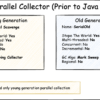Azul Systems offers a commercial proprietary JVM called Zing. Zing (is only available on Linux) uses a proprietary virtual machine which is compatible with the appropriate version of the Java class libraries. Porting a Java application to Zing is as simple as using Zing. Azul initially dove into the hardware appliance business. It released a […]
Archive | JVM
Understanding JVM Garbage Collection – Part 9 Garbage First (G1) Garbage Collector (GC)
Garbage First (G1) Garbage Collector (GC) The G1GC is a server-style generational, incremental, parallel, mostly concurrent, stop-the-world evacuating garbage collector which is suitable for multiprocessor machines with a large amount of memory. G1GC aims to meets garbage collection pause-time goals with high probability, while achieving high throughput. G1GC monitors its stop the world pauses in […]

Understanding JVM Garbage Collection – Part 8 Concurrent Mark Sweep (CMS) Collector
The CMS collector uses an evacuating collector for the young generation and a mostly concurrent mark sweep (non-compacting) algorithm for the tenured. CMS young generation GC is very similar to the parallel collector. The CMS garbage collector also requires coordination between the young and tenured GC. This is why CMS uses a parallel collector […]

Understanding JVM Garbage Collection – Part 7 Mostly Concurrent GC
The main goal of concurrent collectors is to reduce GC pause times. They were developed due to the growing demands for reduced application pause time. GC threads run in conjunction with application threads doing most of the GC work before pausing. Truly concurrent collectors are very hard to achieve as mutator threads keep modifying […]

Understanding JVM Garbage Collection – Part 6 (Serial and Parallel Collector)
JVM GC Implementation The JVM GC is a pluggable subsystem that enables the JVM to execute the same Java program with different GC implementations. Using a new GC algorithm does not require any change to the existing Java program. However, the chosen GC implementation may significantly impact the program’s performance. Java provides three types […]
Understanding JVM Garbage Collection – Part 5 (JVM GC Evolution)
JVM GC Evolution The JVM’s GC algorithms have evolved over the past three decades. The very first GC algorithm shipped with the JVM was the serial collector. Initially, Java was popular on the client side (Java Applets), and the serial collector was perfect for its GC needs. However, the serial collector worked well only on small […]

Understanding JVM Garbage Collection – Part 4
JVM GC Terminology The terminology used to describe garbage collection algorithms can be confusing. In this section, we will explain some commonly used terms and their meanings. Live set – The live set refers to the number of live objects in a heap. The size of the live set has a significant impact on the […]

Understanding JVM Garbage Collection – Part 3
Weak Generational Hypothesis The weak generational hypothesis has had a profound impact on the JVM’s heaps layout. Understanding the weak generational hypothesis is essential in order to understand various GC algorithms and approaches. The Weak Generational Hypothesis states that most objects die young. In other words, most objects created will be garbage collected very quickly. […]

Understanding JVM Garbage Collection (GC Mark , Sweep and Compact Basics) – Part 2
GC Mark, Sweep, and Compact Basics The Mark and Sweep algorithm is the basis for garbage collection in Java. Although the actual algorithms used by the JVM are considerably more complex, the mark and sweep algorithm forms the basis of garbage collection in the JVM and must be understood. As you might have guessed, there […]
Understanding JVM Garbage Collection – Part 1
Java is a popular language for business and enterprise computing. Java and the JVM have enjoyed enormous success over the last two decades. Java was initially considered a slow language (late 90’s). That changed with the introduction of the HotSpot virtual machine in April 99. HotSpot improved performance via “just in time” compilation and adaptive optimisation. Since […]